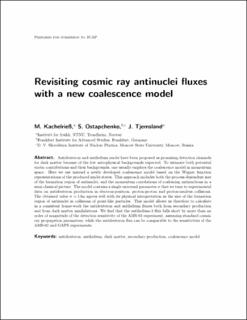| dc.contributor.author | Kachelriess, Michael | |
| dc.contributor.author | Ostapchenko, Sergey | |
| dc.contributor.author | Tjemsland, Jonas | |
| dc.date.accessioned | 2021-02-16T10:29:56Z | |
| dc.date.available | 2021-02-16T10:29:56Z | |
| dc.date.created | 2021-01-07T14:06:44Z | |
| dc.date.issued | 2020 | |
| dc.identifier.issn | 1475-7516 | |
| dc.identifier.uri | https://hdl.handle.net/11250/2728309 | |
| dc.description.abstract | Antideuteron and antihelium nuclei have been proposed as promising detection channels for dark matter because of the low astrophysical backgrounds expected. To estimate both potential exotic contributions and their backgrounds, one usually employs the coalescence model in momentum space. Here we use instead a newly developed coalescence model based on the Wigner function representations of the produced nuclei states. This approach includes both the process-dependent size of the formation region of antinuclei, and the momentum correlations of coalescing antinucleons in a semi-classical picture. The model contains a single universal parameter σ that we tune to experimental data on antideuteron production in electron-positron, proton-proton and proton-nucleus collisions. The obtained value σsime 1 fm agrees well with its physical interpretation as the size of the formation region of antinuclei in collisions of point-like particles. This model allows us therefore to calculate in a consistent frame-work the antideuteron and antihelium fluxes both from secondary production and from dark matter annihilations. We find that the antihelium-3 flux falls short by more than an order of magnitude of the detection sensitivity of the AMS-02 experiment, assuming standard cosmic ray propagation parameters, while the antideuteron flux can be comparable to the sensitivities of the AMS-02 and GAPS experiments. | en_US |
| dc.language.iso | eng | en_US |
| dc.publisher | IOP Publishing | en_US |
| dc.title | Revisiting cosmic ray antinuclei fluxes with a new coalescence model | en_US |
| dc.type | Peer reviewed | en_US |
| dc.type | Journal article | en_US |
| dc.description.version | acceptedVersion | en_US |
| dc.source.journal | Journal of Cosmology and Astroparticle Physics | en_US |
| dc.identifier.doi | 10.1088/1475-7516/2020/08/048 | |
| dc.identifier.cristin | 1867111 | |
| dc.description.localcode | This is an author-created, un-copyedited version of an article accepted for publication/published. IOP Publishing Ltd is not responsible for any errors or omissions in this version of the manuscript or any version derived from it. The Version of Record is available online at http://dx.doi.org/https://doi.org/10.1088/1475-7516/2020/08/048 | en_US |
| cristin.ispublished | true | |
| cristin.fulltext | postprint | |
| cristin.qualitycode | 1 | |
